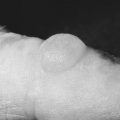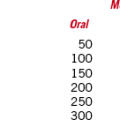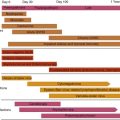Chapter 1 Dynamic Interactions between Hematopoietic Stem and Progenitor Cells and the Bone Marrow
Current Biology of Stem Cell Homing and Mobilization
Relevance to Clinical Hematology
Clinical BMT has gained immense success within the past 4 decades in the treatment of malignant hematologic diseases and immunodeficiency states by providing long-term immune recovery after high-dose chemotherapy.1 The basic premise in BMT is using either a patient’s own stem cells (i.e., autologous BMT) used primarily as stem cell support for myeloma or lymphoma undergoing intensive chemotherapy. Alternatively, allogeneic BMT, performed for the most part in the setting of marrow-infiltrating malignancies such as leukemia, uses donor stem cells infused to a patient, thus capitalizing on the graft-versus-leukemia effect, which affords significant reduction in relapse rate. One of the major clinical obstacles facing BM transplant experts today is the mobilization of the so-called “difficult mobilizers” who fail to mobilize the required amount of CD34 progenitors.2 Known risk factors for insufficient number of HSPCs after mobilization include older age, previous failed mobilization, heavy BM infiltration by tumor cells, and previous chemotherapy and radiotherapy, to name just a few. Several strategies have tried to address this clinical problem using optimize current mobilization protocols, among them high-dose G-CSF regimens, erythropoietin, SCF, and chemomobilization achieved by chemotherapy treatment combined with G-CSF. Despite the wide gamut of therapeutic strategies used, most of them have either failed to show a clear advantage to standard mobilization regimens or were associated with substantial adverse effects (chemomobilization). With the recent introduction of the CXCR4 antagonist AMD3100 (also termed Mozobil and Plorexifor), there is renewed optimism in the management of difficult to mobilize patients. AMD3100 mediates rapid secretion of SDF-1 from BM stromal cells and its release to the circulation,3 resulting in CD34+ progenitor mobilization.4 Treatment with AMD3100 exhibits marked synergism with G-CSF, suggesting their different and complementary mechanisms of action to induce HSPC mobilization. Several studies have shown its success in mobilization of previously failed myeloma in non-Hodgkin lymphoma and Hodgkin lymphoma patients.5
Clearly, because BMT is used increasingly in elderly adults and patients previously exposed to intense chemotherapy, novel approaches for optimizing mobilization are warranted. Several promising approaches are looming over the clinical horizon, among them are novel mobilization agents such as AMD3465,6 SB-251353,7 T140,8 and PTH9 acting in its capacity as a pivotal regulator of the hematopoietic niches. Additional avenues to be explored in this area include the use of cord blood, which at present is limited to pediatric patients and adults of low body weight because of the low number of CD34+ progenitors contained in each cord blood unit. For this reason, the major disadvantage of cord blood transplantation in adult patients is delayed engraftment. Approaches aimed at overcoming the delayed engraftment with cord blood transplantation include double cord blood transplants or together with mobilized or BM-derived CD34+ cell infusion from a matched donor to achieve transient engraftment until the cord blood cells reconstitute the BM.10 In addition, circumventing this inherent limitation of cord blood use may be achieved by improving HSPCs’ homing potential. For instance, inhibition of CD26 allows augmented engraftment of stem cells to the recipient’s BM.11 Upregulation of CXCR4 by PGE2 stimulation increases SDF-1 chemoattraction to the BM.12 Another pathway is activated by CD44 glycozilation,13 which may enhance navigation of treated MSC to the BM. Taking into consideration the bone and BM niches integrity, influencing factors such as age, timing of mobilization, and interplay among different mobilizing agents might be crucial in optimizing HSPCs yield after mobilization and their homing after transplantation. This approach might lead to advanced development of new safe and efficient therapeutic strategies for HSC transplantation protocols.
1 To LB, Levesque JP, Herbert KE. How I treat patients who mobilize hematopoietic stem cells poorly. Blood. 2011;118:4530.
2 Jantunen E, Kvalheim G. Mobilization strategies in hard-to-mobilize patients with lymphoid malignancies. Eur J Haematol. 2010;85:463.
3 Dar A, Schajnovitz A, Lapid K, et al. Rapid mobilization of hematopoietic progenitors by AMD3100 and catecholamines is mediated by CXCR4-dependent SDF-1 release from bone marrow stromal cells. Leukemia. 2011;25:1286.
4 Broxmeyer HE, Orschell CM, Clapp DW, et al. Rapid mobilization of murine and human hematopoietic stem and progenitor cells with AMD3100, a CXCR4 antagonist. J Exp Med. 2005;201:1307.
5 Mohty M, Duarte RF, Croockewit S, et al. The role of plerixafor in optimizing peripheral blood stem cell mobilization for autologous stem cell transplantation. Leukemia. 2011;25:1.
6 Bodart V, Anastassov V, Darkes MC, et al. Pharmacology of AMD3465: A small molecule antagonist of the chemokine receptor CXCR4. Biochem Pharmacol. 2009;78:993.
7 Pelus LM, Fukuda S. Peripheral blood stem cell mobilization: The CXCR2 ligand GRObeta rapidly mobilizes hematopoietic stem cells with enhanced engraftment properties. Exp Hematol. 2006;34:1010.
8 Abraham M, Biyder K, Begin M, et al. Enhanced unique pattern of hematopoietic cell mobilization induced by the CXCR4 antagonist 4F-benzoyl-TN14003. Stem Cells. 2007;25:2158.
9 Ballen KK, Shpall EJ, Avigan D, et al. Phase I trial of parathyroid hormone to facilitate stem cell mobilization. Biol Blood Marrow Transplant. 2007;13:838.
10 Broxmeyer HE, Cooper S, Hass DM, et al. Experimental basis of cord blood transplantation. Bone Marrow Transplant. 2009;44:627.
11 Campbell TB, Hangoc G, Liu Y, et al. Inhibition of CD26 in human cord blood CD34+ cells enhances their engraftment of nonobese diabetic/severe combined immunodeficiency mice. Stem Cells Dev. 2007;16:347.
12 Goessling W, Allen RS, Guan X, et al. Prostaglandin E2 enhances human cord blood stem cell xenotransplants and shows long-term safety in preclinical nonhuman primate transplant models. Cell Stem Cell. 2011;8:445.
13 Sackstein R, Merzaban JS, Cain DW, et al. Ex vivo glycan engineering of CD44 programs human multipotent mesenchymal stromal cell trafficking to bone. Nat Med. 2008;14:181.






